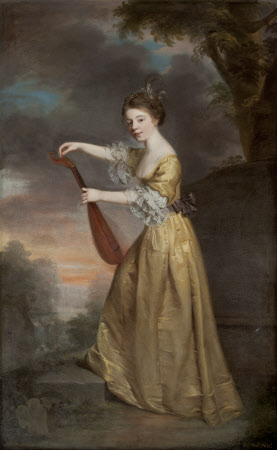Sophia Anne Delaval, later Mrs John Jadis (1755 - 1793), as a girl, tuning a Mandolin in a Landscape Setting
William Bell (c.1735 - 1794)
Category
Art / Oil paintings
Date
1770 (signed and bears date)
Materials
Oil on canvas
Measurements
2387 x 1473 mm (94 x 58 in)
Place of origin
Newcastle upon Tyne
Order this imageCollection
Seaton Delaval Hall, Northumberland
NT 1276754
Caption
This portrait is one of a series, depicting Delaval family members, which now hang in the Gallery at Seaton Delaval. There are pentimenti (changes to the painted outlines) in her head and arms, which suggest that she could previously have been in stronger profile, in order to reflect the portrait of her sister, Elizabeth. Sophia was the second daughter of John, Lord Delaval. She returned from her travels in Europe ‘married’ to a Henry Devereux of Bordeaux and pregnant. She later returned to France for a year, but this time came back with another husband, a John Jadis, who did not fit in with the Delavals, at one point quarelling with his brother-in-law, Lord Tyrconnel, and challenging him to a duel. For most of his life, William Bell was a provincial painter in Newcastle-upon-Tyne. This series of portraits is undoubtedly his masterpiece, showing him to have been a gifted and individual painter, influenced by Reynolds and Kauffman.
Summary
Oil painting on canvas, Sophia Anne Delaval, later Mrs John Jadis (1755 - 93), as a girl, tuning a Mandolin in a Landscape Setting by William Bell (1735 - Newcastle ?1806), signed, bottom right: Wm. Bell Pinx.t and inscribed, bottom left: Sophia Anne Delaval 1770. Full-length portrait, standing, wearing a yellow dress, with lace cuffs tuning a mandolin; landscape background
Full description
The second daughter of John, Lord Delaval. At the age of 21 she travelled in Europe, where she met her first husband, Henry Devereux of Bordeaux. In 1778 she returned, pregnant, but without her ‘husband’, and later gave birth to a boy, Henry (in the church register Sophia is given the surname ‘Delaval’ – later crossed out, with ‘Devereux written above). She later returned to France for a year, but this time came back with another husband, a John Jadis (an ensign in the 59th Regiment of Foot), whom she had purportedly married in the Catholic Cathedral in Brussels. On the insistence of her father, they were married again, on 6th February 1780, at St. Mary’s, Lambeth. Needless to say, Jadis did not fit in with the Delavals, at one point quarelling with his brother-in-law, Lord Tyrconnel, and challenging him to a duel. Sophia endured her husband for some six years, at which point they parted. He was paid £100 per annum by Sir John. Sophia died in 1793, leaving unpaid bills (probably for opium) for £96. Her son was brought up by his grandmother, Susanna, at Seaton. (see M. Green, The Delavals. A Family History, Newcastle, 2007, pp.97-8). There are pentimenti in her head and arms – could she have previously been in stronger profile to match her sister, Elizabeth? It is not known exactly where these pictures hung, although it seems most likely that they were in the Saloon (there is insufficient space in the Entrance Hall). The daughters are framed in a later and a simpler type of frame (c.1800) than those of Susanna and the two males. It seems possible that their frames were changed in order that they might fit into an alternative location. William Bell is little known for two reasons: that he was for most of his life a provincial painter, in Newcastle-upon-Tyne; and that for half a decade or more, from about 1770 to at least 1775 he was “limner” – the term was as old-fashioned as the mode of employment – to Sir John Hussey Delaval (cr. Baron Delaval of Redford in the Irish Peerage in 1783, and Seaton Delaval in the British Peerage in 1786. Yet these portraits show him to have been a gifted and individual painter, and his London career was much more promising. He was – at the advanced age of 34 – the first student to enter the newly-founded Royal Academy’s Schools in 1769, and won a gold medal there for a painting of Venus Entreating Vulcan to forge Arms for Aeneas in 1771. It seems likely that he was related to Alexander Bell, who carved stonework at Seaton Delaval between 1764 and 1768, and who returned there in 1776 to build the mausoleum. That may have been the connection that brought William to Seaton Delaval, where he not only painted the four original whole-lengths, but also extended earlier family portraits to make a set with them. They all hang in the Gallery, along with the Astley / Hasting chairs and settees upholstered with the Tournament embroidery. Other portraits by Bell are in what is now the main repository of Delaval pictures, Doddington Hall, Lincolnshire. After this activity for Lord Delaval, Bell retired back to Newcastle, and sank into provincial obscurity. He seems, towards the end of his life, to have became the friend of Thomas Bewick, the wood-engraver of Cherryburn (NT). (Amanda Bradley)
Provenance
accepted in lieu of tax by HM Treasury and transferred to the National Trust in 2009
Credit line
Seaton Delaval, The Hastings Collection (National Trust)
Marks and inscriptions
Recto, bottom right : signed: Wm. Bell Pinxt. Recto, bottom left: Sophia Anne Delaval. 1770 Recto: SOPHIA ANN, afterwards Mrs. Jadis. b.1752. d. 1793 / 2nd daughter of John, Lord Delaval. / WILLIAM BELL. 1770
Makers and roles
William Bell (c.1735 - 1794), artist
